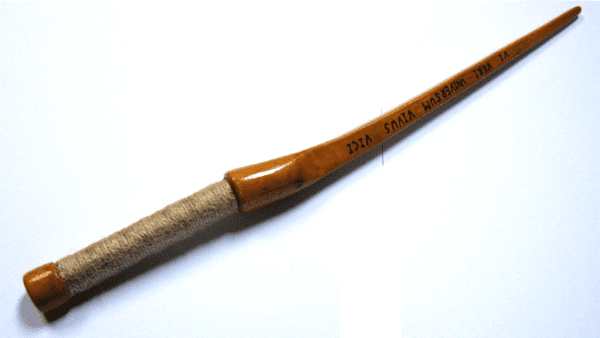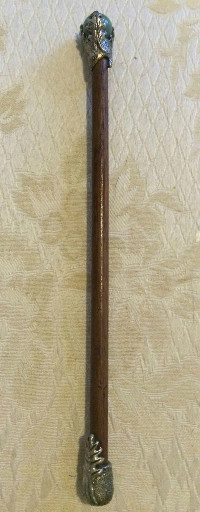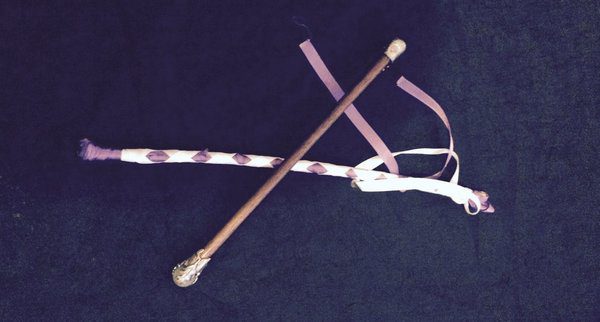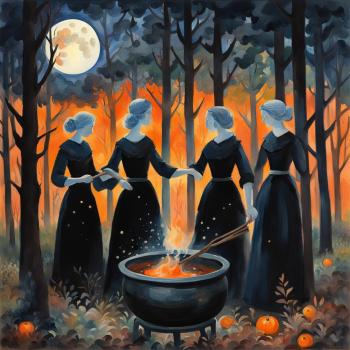Wand Basics
One simply does not serve soup with a butter knife!
(We are honored to have Gypsey Elaine Teague as a guest here at Agora and Patheos Pagan. Not only are we running an excerpt from her latest book The Witch’s Guide to Wands, but we’ve also got a little guest post in the middle of the excerpt. You can order Gypsey’s latest book here and read a review of the book at this link. Thanks to Red Wheel/Weiser for contributing here at Patheos Pagan! -Jason, Editor & Harmless Drudge)
Wands. Without them we would be missing a great part of our tool kit. Scott Cunningham says in his book Wicca: A Guide for the Solitary Practitioner that you can even use a wooden dowel purchased from a hardware store as a wand. While that is true, and any piece of wood works under general conditions, it really is important to know the source of your mate¬rial and the conditions under which that piece was obtained.

Another staple reference book of witchcraft is Raymond Buckland’s Complete Book of Witchcraft. Here, Buckland says that the power of the wand comes from the witch and not necessarily from the wand. I agree with that to a point. While you may practice magic naked with your index finger, it is important that you understand the power of the tools if you are going to use them. Therefore, I believe you should choose your wand more carefully than either Buckland or Cunningham suggest.
There is a partnership between the witch and the wand. Any witch who has his or her favorite or working wand will tell you the energy gener¬ated between the wand and the witch is significant and prevalent. Wands are like shoes or jeans or shirts or your favorite little black dress. When it’s right, it’s just right and you know it. Therefore, when you craft your first or third or ninth wand and it doesn’t respond to you, don’t worry. A piece of wood in the wild or in the lumberyard is very different once you begin talking to it and crafting it. Think of building your relationship with your wand as dating. You may go out on a number of dates with a number of different people before you get the right spark. And even then, after mar¬riage the spark may still not be right. So it is with your wand. Work for the spark, but don’t expect overnight success.
For a more detailed approach to wands, I recommend Dorothy Morrison’s book The Craft: A Witch’s Book of Shadows. Morrison goes into detail about the particular properties of wands and explains that it’s just not about wandering aimlessly, gathering sticks and twigs in the hopes that one might become a wand. She explains the harvesting of the wand, which I think is an essential part of all witch’s training. She also goes into detail about personalizing your wand after you have procured the material. These are all important aspects of the training young witches should receive.
Most authors agree that a wand should be approximately the length from the tip of your middle finger to the crook of your arm. This makes it the length of your hand and forearm. To me, that is a little long, and I personally like a shorter wand of about fourteen inches. But this book is not about length as much as it’s about substance, so I’m not going to lay down some grand law to follow in making your wand.
“All Wands Are Different?”
This is a question I get a lot when traveling and talking about wands and their properties. Many folks think that wood is just wood and if they think of the types at all many of them stay within the pantheon that they practice. In actuality all woods are different and therefore carry energy unique to their structure and thusly carry magic the same way.
Many times I have said that one simply does not serve soup with a butter knife. It’s a silly statement if you think of it since you would never attempt to serve a liquid with a flat surface but in reality we do that with our wands. A dense wood such as Ebony or Lignum Vitae will feel much different than a lighter wood like Wisteria or Basswood. While they are all vascular their structures are so different that it would be like trying to compare a car battery and a jar with two electrodes in salt water. They both create power but don’t try starting your car with a jar and some salt.
To that end I wrote a book. I think it’s a very good book but I’m a little, okay a lot, biased. What the book is, though, is an explanation of wands from a number of points of view. The book is first and foremost a book on the spiritual properties of woods and metals used in wands. However each item starts out with a number of other areas covered.
First each wood and metal is discussed in terms of origin. Where did the item come from? What kind of place is it found and what does it look like? As a Landscape Architect I talk about the wood itself, the taxonomy, the families and other woods of like mind.
I am also a wood worker, therefore next I discuss the hardness and how that lends itself to being made into a wand. Do you use a lathe or hand tools? Is the hardness scale so high or low that you must practice caution when applying tools to the wood? Ebony and Ipe are wonderful woods to work with but depending on the grain and the humidity may be heinous to turn on a lathe. And even though Eastern Red Cedar is a wonderful soft wood it is the worst wood to try to turn on a lathe because there are so many knots and the wood is exceptionally soft that even the slightest catch of the chisel will split the wand in two.
What myths and legends are concerned with the wood or metal? Each specimen has a section of legends and myths that may or may not affect the properties of the wand and the wand’s temperament. Please remember that wands are like people. Some are pretty, some are not. Some are fat, some are not. Some are straight and some are not. Some are nice and some, well some are not.
Finally the properties for the wood. What does the wand do and how well may you anticipate the results. If you want a healing wand then you don’t want a Black Walnut wand. Or if you want a wand for cooking then don’t expect a White Willow wand to be your best choice. The properties are just not there for those uses. That’s the nature of wands. The more you work with them the better you understand them; but again that’s also like people.
It is important to understand that there are wands and then there are wands. With the popularity of Harry Potter, wands have gained an elevated status in pop culture. An entire generation has grown up with a renewed sense of wand appreciation not seen since Disney’s Cinderella of 1960. Now, not just witches and fairy godmothers wield wands—every young child who has read Rowling’s books and envisioned him- or herself as a wizard at Hogwarts has a wand in hand.
 Unfortunately, these same children grow up not understanding the difference between a play stick called a wand and a wand as held by an actual magician. These children and adults believe that you can put a phoenix feather or a unicorn hair into a wand to gain more power against the Dark Lord. So is the way of popular culture, I suppose. However, for a detailed explanation of the wands of the Harry Potter books and how they correspond to the characters they chose, see the section later in this book.
Unfortunately, these same children grow up not understanding the difference between a play stick called a wand and a wand as held by an actual magician. These children and adults believe that you can put a phoenix feather or a unicorn hair into a wand to gain more power against the Dark Lord. So is the way of popular culture, I suppose. However, for a detailed explanation of the wands of the Harry Potter books and how they correspond to the characters they chose, see the section later in this book.
There is a saying that one simply does not serve soup with a butter knife. This means we do not use the same tool for every occasion. In construction, people say that if all you have is a hammer, then everything begins to look like a nail. That is very true with wands. If we have one and only one wand, then I believe we can only do spells or rituals that accommodate that one particular wand. You can’t successfully perform a vast array of spells with a single wand any more than you can cook and serve an entire feast with a single butter knife. You must have more than one. This is a book of choices.
This book is also a book of construction. Each wand discussed will include how the wand was made. The lathe is just a tool; but then again, so is a wand. Some wands should be crafted at specific times and days of the month or even the year. If you cast a variety of spells and perform a pleth¬ora of rituals, then you should, and I say “should” since I don’t want to be accused of being dogmatic, have a wand for each area within which you are working. And not all wands should be from a single material. Wands are like anything else you use. If you must have two or three traits for a spell, then why not turn a wand out of two or three different woods?
Wands are also like batteries; there is a positive end and a negative end. I polled my witch community to ask how they use their wands. Over 90 percent said they use the pointy end only, which we will refer to as the head of the wand. A good friend added that if the wand is unidirectional—that is, one end is pointier than the other—then he will only cast with the head, but if he has a wand that has no head, then he considers it a bidirectional wand and either end will do. I agree with that wholeheartedly for him, but I contend that even if there is a head and a base, you still may use both ends.
A battery is powerful from both ends, and you must connect a wire to each end to draw the current from it. So is it with a wand. However, do not think of the metaphor of the battery as a discussion of good and evil. The positive and negative ends of the battery are just two sides of the same force, like two sides of the same coin. Neither is better or worse. They are used in conjunction to be a complete whole. Sort of like the yin and yang of the power you are holding.
If you are using a peach wand, the properties are both positive—love and fertility—as well as negative—exorcism. For love and fertility you would hold the base and direct your energy with the head. If you were working an exorcism or banishing spell, then you would need more of a negative power, the power of the base, and therefore you would turn the wand around and hold the head and use the base.
The section of the wand between the base and the head is the shaft. Some bases are ornamental or embellished. In a metal wand, the base may be large and fashioned around a crystal. In an organic wand, the base may be finely tooled or turned and marked with sigils or other symbols import¬ant to its user. Therefore, the base may extend far into the shaft, but that is what the wand dictates.
__________
Gypsey Elaine Teague is the author of The Witch’s Guide to Wands and Steampunk Magic, both published by Weiser Books. She is the Branch Head of the Gunnin Architecture Library at Clemson University as well as a member of the National Board of Certified Counselors, an Elder and High Priestess in the Georgian tradition, a High Priestess in the Icelandic Norse tradition, and a High Priestess and originator of Steampunk Magic. Teague is published in a number of areas and presents nationally on Steampunk history, literature, and popular culture.
Excerpt from The Witch’s Guide to Wands reprinted with kind permission from Red Wheel/Weiser, LLC.


















